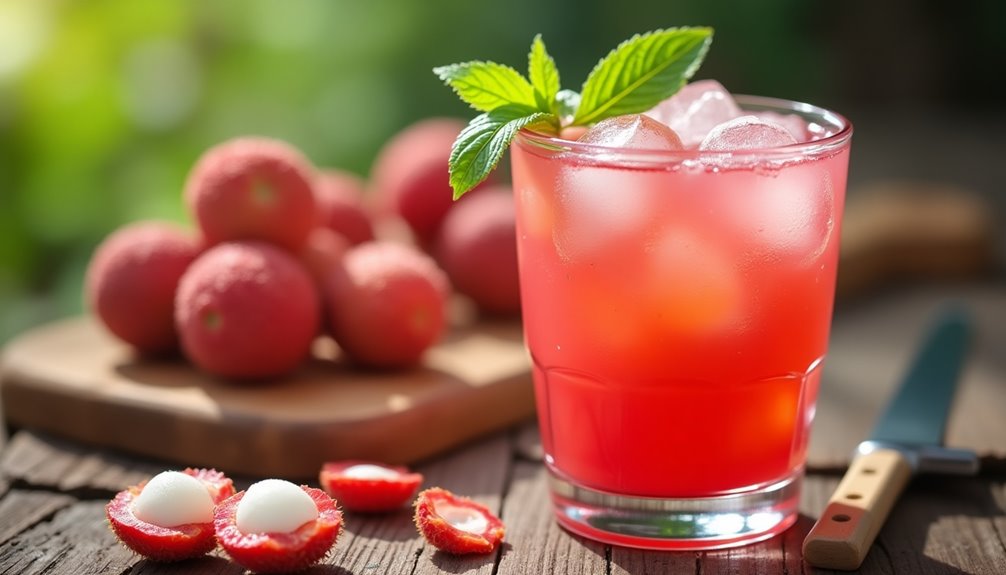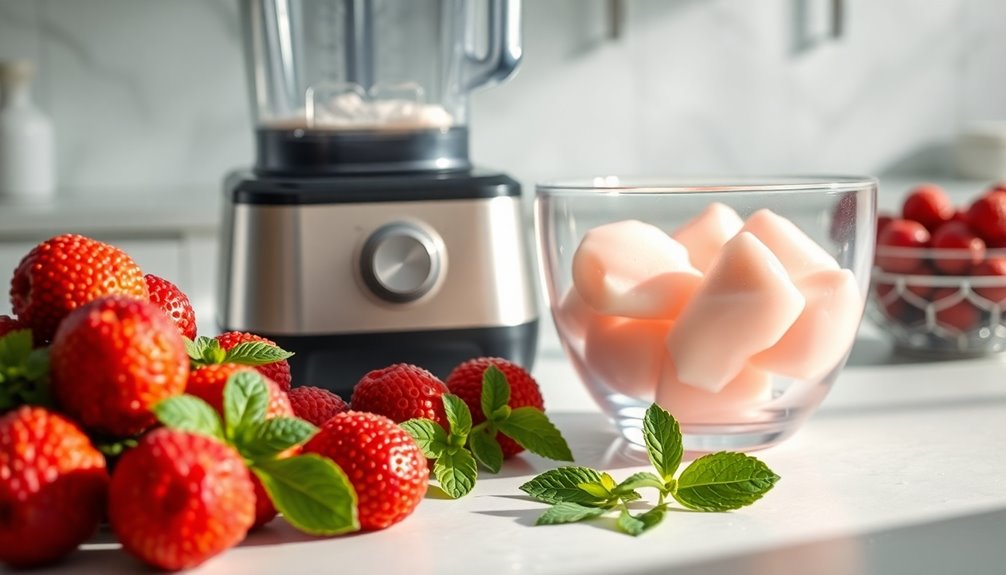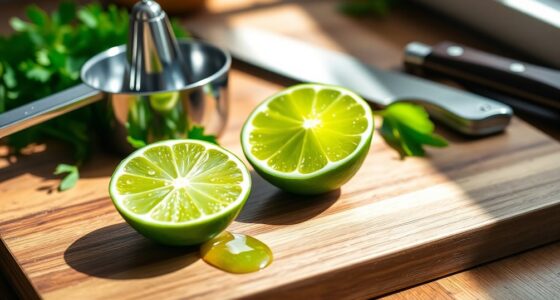To make lychee juice, peel and seed 15 to 20 fresh lychees and blend them with 5 to 6 fresh mint leaves and 2 tablespoons of sugar. Add 2 cups of chilled water and blend until smooth. Strain the mixture using a fine-mesh strainer to separate the juice from the pulp. Serve the silky lychee juice over ice and consider garnishing it with mint or lemon for extra flavor. There's more to discover about variations and storage tips!
Key Takeaways
- Peel and seed 15 to 20 fresh lychees, or use canned lychees as an alternative.
- Blend lychees with mint leaves, sugar, and chilled water until smooth.
- Strain the blended mixture using a fine-mesh strainer to separate juice from pulp.
- Serve the strained lychee juice over ice cubes, garnished with mint or lemon.
- Store leftover juice in the fridge for up to three days or freeze for later use.

If you're craving a refreshing summer drink, making lychee juice is a delicious and simple way to quench your thirst. This exotic fruit, with its sweet and floral flavor, can transform your ordinary beverage into something extraordinary. You'll love how easy it's to prepare, and the result is a delightful drink that's perfect for hot days. Not only does lychee juice taste amazing, but it's also rich in Vitamin C, which boosts your immune system and adds an extra health benefit to your drink.
To get started, you'll need about 15 to 20 fresh lychees. If fresh ones aren't available, you can use canned lychees as a convenient alternative. The first step is to peel and seed the lychees carefully. Once you've removed the outer skin and their large pits, you'll be left with the juicy, tender fruit ready to be blended.
Place the peeled lychees in a blender along with 5 to 6 fresh mint leaves. The mint adds a refreshing twist that complements the sweetness of the lychees perfectly. Next, add 2 tablespoons of sugar to the mixture. You can adjust the sweetness based on your personal preference, but a little sugar helps to enhance the natural flavors.
Then, pour in 2 cups of chilled water to help blend everything smoothly. Blend the mixture until it reaches a smooth consistency, ensuring all the lychees and mint leaves are thoroughly combined.
Once blended, it's time to strain the mixture. Use a fine-mesh strainer to separate the juice from the pulp. Press the blended mixture with a ladle to extract as much juice as you can. This step is crucial, as it ensures you get a silky, smooth lychee juice, perfect for sipping.
Now that you have your fresh lychee juice, serve it over ice cubes to keep it cold and refreshing. If you want to elevate your drink further, consider garnishing it with a sprig of mint or a slice of lemon for a burst of color and flavor. The combination of the sweet lychee and zesty lemon juice can make your drink even more delightful.
If you find yourself with leftover juice, don't worry! Store it in an airtight container in the fridge for up to three days. You can also freeze it in ice cube trays for up to two months, making it a convenient option for future drinks.
For a fun variation, mix your lychee juice with soda water for a sparkling mocktail, or blend it with other fruits like apple or dragon fruit for added flavor.
With just a few simple steps, you'll have a refreshing drink that's perfect for summer gatherings or just a relaxing day at home. Enjoy your homemade lychee juice!
Frequently Asked Questions
How to Make Lychee Juice From Lychee?
To make lychee juice from lychee, you'll first peel and deseed the fresh fruits.
Blend those lychees with chilled water and sweetener until smooth.
Once blended, strain the mixture to remove any pulp, using a ladle to press for maximum juice extraction.
Serve over ice for a refreshing drink.
If you have leftovers, store them in an airtight container in the fridge or freeze them in ice cube trays for later enjoyment.
How to Make Lychee Syrup at Home?
To make lychee syrup at home, combine equal parts peeled and pitted fresh lychees and granulated sugar in a saucepan.
Add a splash of water to help dissolve the sugar, then heat it over medium-low, stirring until dissolved and bubbly.
Once it boils, reduce the heat and let it simmer for 10-15 minutes.
Afterward, strain the syrup through a fine-mesh strainer and store it in an airtight container in the fridge.
Enjoy!
What Are the Ingredients in Litchi Juice?
Imagine the sweet, tropical aroma wafting through your kitchen as you prepare for something delicious.
To create litchi juice, you'll need fresh lychees—15 to 20 peeled and seeded fruits to start. For an extra kick, toss in 5-6 mint leaves.
Don’t forget to add sweetness, using about a cup of sugar, honey, or maple syrup. A splash of citrus from lime or lemon juice and 2 cups of chilled water completes the mix. Once you have combined all the ingredients, stir well to ensure everything is properly blended. For an extra layer of flavor, consider adding a few sprigs of fresh mint or a slice of cucumber. Now that your refreshing beverage is ready, follow the muscadine juice recipe instructions for serving suggestions and tips on how to enhance the taste even further. Enjoy your delightful drink on a warm day or as a perfect complement to your meals!
What Is Lychee Drink Made Of?
A lychee drink is mainly made from fresh lychees, which you peel and seed before blending.
You'll mix the lychees with water to create a refreshing base. To enhance the flavor, consider adding mint or lime juice.
If you want it sweeter, you can stir in sugar, honey, or maple syrup. Alternatively, you can use canned lychees, but they may not have the same vibrant flavor as fresh ones.
Serve it chilled!
Conclusion
In conclusion, making lychee juice is simple and rewarding. You've chosen fresh lychees, you've peeled and pitted them, and you've blended them into a refreshing drink. Now, you can savor the sweet, tropical flavor, share it with friends, and enjoy the burst of freshness. So, whether you sip it on a sunny day or serve it at a gathering, you'll be glad you made this delicious beverage. Cheers to your homemade lychee juice!
Cindy thoroughly researches juicing trends, techniques, and recipes to provide readers with practical advice and inspiration. Her writing style is accessible, engaging, and designed to make complex concepts easy to understand. Cindy’s dedication to promoting the advantages of juicing shines through her work, empowering readers to make positive changes in their lives through the simple act of juicing.











